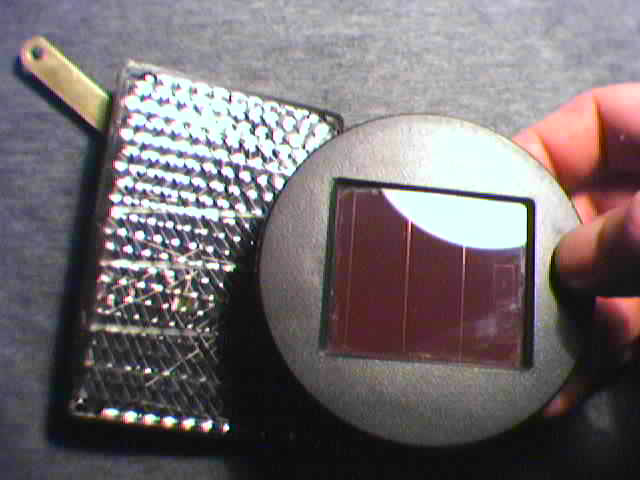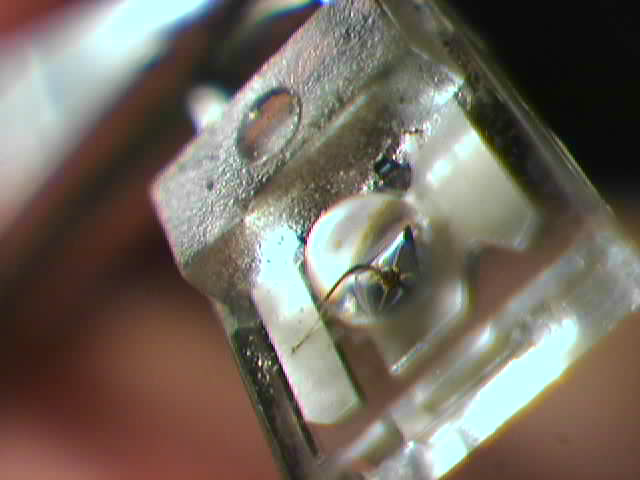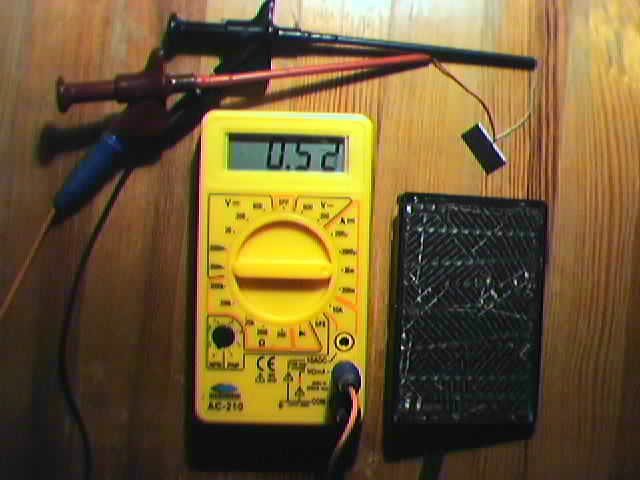There are several readily available electronic components that are light-sensitive and permit us to measure the intensity of light:
- photoelements or solar cells produce electricity
when light shines on them. They can be found in small battery
chargers and the small lamps that we may employ to illuminate
a garden path in the night while the internal battery is
charged during the day. The great advantage of these photocells
is that the electrical current they deliver increases strictly
with the light intensity.
The image below shows two examples, and another small photoelement
in shown in the image after this:

- photoresistors are small components whose electrical
resistance goes down when light shines on them. They are used
to increase the brightness of a display when the ambient light
increases. Photoresistors often are made to have the same
spectral sensitivity as the human eye. However, the relationship
between resistance and light intensity is usually non-linear
and therefore requires calibration.
The image below shows a large one on the left and two
small ones (about 5 mm across) at upper right. At bottom right
there is a small photoelement.

- photodiodes and phototransistors are very small
components which allow a greater electric current to pass
though when light shines on them. They are found in various
applications, for instance they sense the movement of a
computer mouse. Photodiodes and especially phototransistors
can be very sensitive, but they are usually more sensitive in
the infrared, which makes them less suitable to measure the
intensity of the visible light, which may be of greater
interest to us! The image below shows a photodiode from
a computer mouse. The device is about 5mm across, and the
light-sensitive chip is seen through the small plastic lens
as the dark-blue area, with a gold wire to make the electrical
connection.

Experiment: How the light intensity diminishes with distance from the light source
Material needed
- photoelement
- analog or digital multimeter to measure electric current
- measuring tape or long ruler
- small light source in a dark room

What we do
Connect the multimeter - set to measure electric current, perhaps a few mA - to the photoelement. The light source could be a desk lamp with no or but a small lamp screen, a naked clear bulb or the small low-voltage lamps would be fine. Place the photoelement at some (measured) distance from the light source and measure the current. Repeat this for several distances, always holding the photoelement oriented towards the source. You might rotate it a bit in order to get the maximum current.
If you plot the current values against the distance, you will notice that the current decreases with distance. In fact it decreases with the square of the distance. You can show this by entering the data in Excel and overplotting a curve y = A/distance with some suitable value A.
There is an even nicer way to prove this relation: plot the currents against the square values of the distance, and the measured points will form a straight line!
A quick way, for a demonstration, would be to see that the current increases by a factor four everytime you half the distance!
Interpretation
The reason why the measured brightness decreases with the square of the distance is rather simple but fundamental: The light source radiates its power in all directions. If we imagine a spherical surface with some radius r around the source, the power flowing through the entire surface will always be the total power of the source, whatever the radius of the sphere. But since the surface area of the sphere increases with the square of its radius, each square centimetre of the sphere receives a portion of this total power which diminishes with the square of the sphere's radius. Thus, the power picked up by the photoelement - which has a given fixed area - goes down with the square of its distance from the source.
This law is the reason why more distant stars appear to be less bright.
| Top of the Page | Back to the MainPage | to my HomePage |
last update: March 2010 J.Köppen